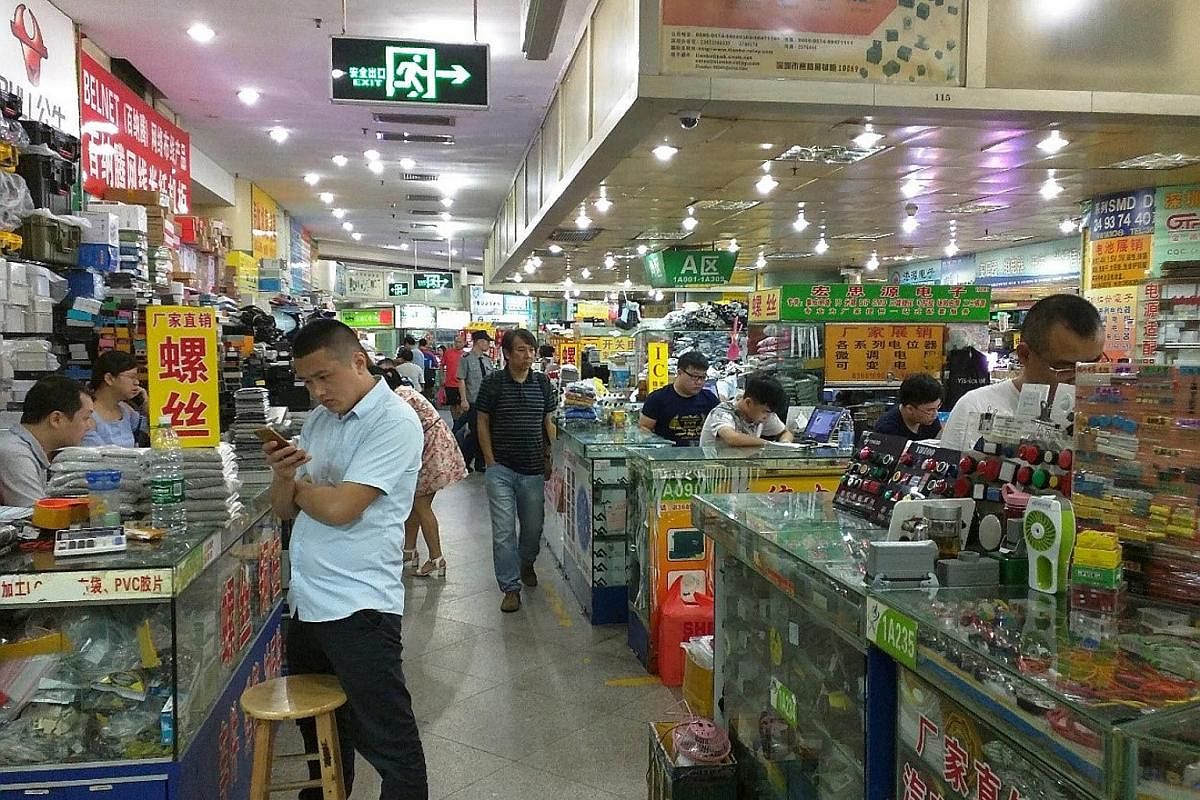-

WHO: Bachelor Mr Akmal Abd Rahman (right), 37 Co-founder of Tinkercademy, a company that teaches coding and tinkering to schools, corporations and the public in Singapore.
Travel Black Book CEO Series
Travel Black Book: Electronics heaven in Shenzhen
Shenzhen, the hardware capital of the world, is the place to go to source electronic parts and explore cool new gadgets


WHO: Bachelor Mr Akmal Abd Rahman, 37 Co-founder of Tinkercademy, a company that teaches coding and tinkering to schools, corporations and the public in Singapore.
Favourite destination: Shenzhen, China. There is no other place in the world like it. It is where the majority of the electronics we use daily are manufactured and where the headquarters of technology giants, such as Tencent, which is behind messaging app WeChat, and telecommunications company Huawei, are located.
In the space of a generation, Shenzhen transformed from a sleepy city to the hardware capital of the world. People come from all over China and the globe to build the future here. You can feel the energy as you walk the streets and interact with people.
Since Shenzhen is always evolving, there is something new to see on each trip, whether a building or a prototype of a smart device about to be unleashed.
I go there once or twice a year to source electronic parts and explore cool new gadgets. We also take students there on learning journeys to expose them to what is happening in the tech world.
SEE
Although Shenzhen is more well known as a business and manufacturing centre, it offers a surprising number of tourist destinations where one can get away from the bustle of the city.
China is famous for its replicas of world landmarks and European towns that have been built around the country. Window of the World (bit.ly/1CuKzkq) is a park where replicas of landmarks such as the Eiffel Tower, pyramids, Taj Mahal and Leaning Tower of Pisa have been created at ratios of 1:1, 1:5 or 1:15.
-
GETTING THERE
-
There are at least three direct flights a day between Singapore and Shenzhen.
The city is conveniently located between Hong Kong and Guangzhou. There are several border crossings where you can seamlessly move between Shenzhen and Hong Kong via MTR, bus and ferry. The trips take 11/2 to two hours. There are also trains linking Shenzhen and Guangzhou.
I usually go via Hong Kong International Airport (there are at least 18 direct flights daily between Singapore and Hong Kong). You can take a bus from the airport to an MTR station and cross the border at Lo Wu/Luohu (bit.ly/2GBhQUF). The metro extends all the way to the edge of the border on both sides and the total trip costs about HK$100 (S$16.70).
-
TIPS
• You need to clear Chinese immigration even if you are coming from Hong Kong, so make sure you have the proper visa.
• Go in spring or autumn, when it is slightly cooler.
• Stay for a week. The variety of activities and proximity to both Hong Kong and Guangzhou ensure you will never run out of things to do.
• Most payments are done through WeChat's WePay or Alipay by Chinese conglomerate Alibaba. But because of the number of tourists, many merchants, including eateries and taxis, still accept cash. Try to bring smaller denominations.
• It is cheaper to buy a Chinese SIM card, but if you use a Singapore phone on a roaming plan, the Great Firewall of China will be less obtrusive. Still, many chat, search and map apps will be blocked, including most by Google and Facebook, so get ready to use Baidu, China's search engine, and messaging app WeChat . If you meet anyone here and wish to stay in touch, you are probably going to be using WeChat.
• Shenzhen has reliable public transport, but I have not managed to figure it out. It is easy to hail a cab, but if you need to book one via an app, you will need to download Didi Chuxing, a ride-sharing app.
I'm an avid hiker and nature lover and, although my work trips to Shenzhen are often spent in the concrete jungle, I like escaping to the Xianhu or Fairy Lake Botanical Garden, a beautiful 546ha park with more than 8,000 species of plants and large themed gardens.
Although I'm not a keen art lover, the prosperity generated in Shenzhen has led to a growing interest in art. Art aficionados can check out places such as the OCT Art and Design Gallery (www.oct-and.com), a former warehouse which is now a showcase of graphic design, and He Xiangning Art Museum (www.hxnart.com) for contemporary art.
EAT
Although Shenzhen is located in Guangdong province and right next to Hong Kong, there are dining options other than Cantonese fare. People have moved from all over China to seek their fortunes in Shenzhen, bringing their regional cuisines with them. Restaurants serving spicy Sichuan food are particularly popular.
My search for halal food has been a unique adventure. The first time I visited Shenzhen, I did a lot of online research for halal restaurants, but because Google and Google Maps are blocked in China, I could find only a few references online. And once in the area, finding the restaurants was a challenge as the street and restaurant names were all in Chinese. Now, I find my favourites by memory.
Fortunately, there are a good number of eateries around the electronics manufacturing hub in the Huaqiangbei area. There, I also stumbled upon many more halal restaurants, mostly serving cuisine from Xinjiang, a province in China's north-west where close to 60 per cent of the population is Muslim.
I discovered a few Turkish restaurants too. Many people from the Middle East and Turkey come to Shenzhen to source parts, so these restaurants opened to cater to them.
Most of the Xinjiang restaurants are similar to one another and I recommend trying the beef bowl noodles and oily meat buns, which are usually very good.
Another treat is the Uighur laghman noodles. Laghman roughly translates to la mian or ban mian in Mandarin, but this dish is pretty different from the la mian Singaporeans know. The noodles are hand-pulled and taste very fresh, with a nice bouncy texture. A thick, meaty broth or stew made with ground lamb meat, herbs, potato, tomato, onion and pepper is ladled over the thick noodles.
Most of the Xinjiang restaurants I've come across are good. Otherwise, you can ask for directions to Zhong Fa Yuan Muslim Restaurant, a chain with locations around the city.
If you like Turkish cuisine, you can get familiar favourites such as kebabs, shawarma, baba ghanoush and milk pudding at places such as Mevlana Turkish restaurant, which is conveniently located in Huaqiangbei.
At the cheaper places, a food item costs roughly between 15 and 25 yuan (S$3 and S$5).
PLAY
Maker Faire Shenzhen (www.shenzhenmakerfaire.com) is the largest maker faire in Asia and among the four largest ones in the world. A maker faire is part convention, part market, where booths showcase wacky DIY inventions, interactive artwork, lots of robots and tons of new and exciting electronic gadgets. The faire takes place every year during October or November and there's always something new to see. The innovation and ingenuity of the exhibitors blow my mind every time.
Less than an hour's drive east of the city, Dameisha Beach is a scenic and unexpected getaway from the city, with a long, sandy beach and scenic mountain views. You can swim, ride horses and take dune buggy rides as well as attend rock concerts there in the summer.
SHOP
The best place to shop is definitely Huaqiangbei, which is like the Orchard Road of Shenzhen, but for electronics instead of fashion. It is a famous electronics market that sprawls over several buildings and it will test even the most seasoned shoppers and bargain-hunters.
Sellers group together, so you'll find a floor of vendors selling LED strips, another floor with vendors selling security cameras, and yet another floor selling SD cards, for example. Sellers will generally tell you what is genuine and fake.
People have built an iPhone buying individual parts from the market. It is also an ideal place to pick up geeky gifts such as a programmable LED name badge or a cheap, possibly too cheap, mini drone.
It's a bit more difficult and, at times, inconvenient for a non-Mandarin speaking person like me to get around and buy stuff here, but one can usually get by with a lot of hand-waving, pointing and sketching.
To find your way around, I recommend getting The Essential Guide To Electronics In Shenzhen by Andrew 'Bunnie' Huang, an American researcher and hacker. The book provides tips, directions and helps non-Mandarin speakers make their way around the market.
STAY
I stay at the basic but nice Shanshui Trends Hotel Shenzhen Huaqiangbei (www.shanshuihotel.com/index.htm) because it is a stone's throw away from the Huaqiangbei markets.
However, Shenzhen has a full range of accommodation options - from hostels for backpackers to five-star hotels.
Join ST's Telegram channel and get the latest breaking news delivered to you.
A version of this article appeared in the print edition of The Sunday Times on February 04, 2018, with the headline Travel Black Book: Electronics heaven in Shenzhen. Subscribe


